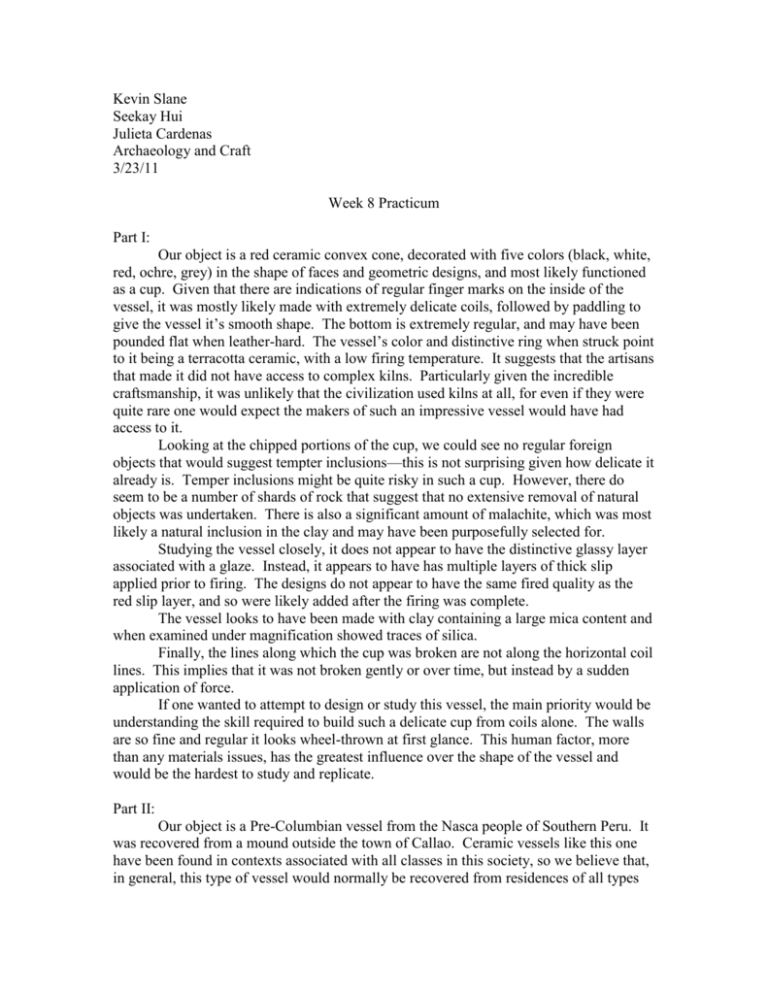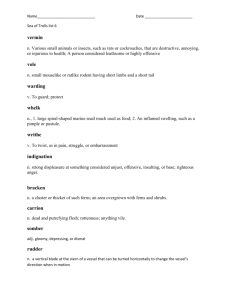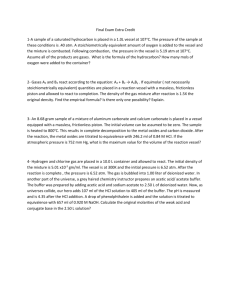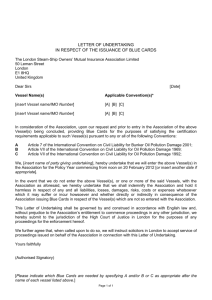week8practicum_KevinSeekayJulieta
advertisement

Kevin Slane Seekay Hui Julieta Cardenas Archaeology and Craft 3/23/11 Week 8 Practicum Part I: Our object is a red ceramic convex cone, decorated with five colors (black, white, red, ochre, grey) in the shape of faces and geometric designs, and most likely functioned as a cup. Given that there are indications of regular finger marks on the inside of the vessel, it was mostly likely made with extremely delicate coils, followed by paddling to give the vessel it’s smooth shape. The bottom is extremely regular, and may have been pounded flat when leather-hard. The vessel’s color and distinctive ring when struck point to it being a terracotta ceramic, with a low firing temperature. It suggests that the artisans that made it did not have access to complex kilns. Particularly given the incredible craftsmanship, it was unlikely that the civilization used kilns at all, for even if they were quite rare one would expect the makers of such an impressive vessel would have had access to it. Looking at the chipped portions of the cup, we could see no regular foreign objects that would suggest tempter inclusions—this is not surprising given how delicate it already is. Temper inclusions might be quite risky in such a cup. However, there do seem to be a number of shards of rock that suggest that no extensive removal of natural objects was undertaken. There is also a significant amount of malachite, which was most likely a natural inclusion in the clay and may have been purposefully selected for. Studying the vessel closely, it does not appear to have the distinctive glassy layer associated with a glaze. Instead, it appears to have has multiple layers of thick slip applied prior to firing. The designs do not appear to have the same fired quality as the red slip layer, and so were likely added after the firing was complete. The vessel looks to have been made with clay containing a large mica content and when examined under magnification showed traces of silica. Finally, the lines along which the cup was broken are not along the horizontal coil lines. This implies that it was not broken gently or over time, but instead by a sudden application of force. If one wanted to attempt to design or study this vessel, the main priority would be understanding the skill required to build such a delicate cup from coils alone. The walls are so fine and regular it looks wheel-thrown at first glance. This human factor, more than any materials issues, has the greatest influence over the shape of the vessel and would be the hardest to study and replicate. Part II: Our object is a Pre-Columbian vessel from the Nasca people of Southern Peru. It was recovered from a mound outside the town of Callao. Ceramic vessels like this one have been found in contexts associated with all classes in this society, so we believe that, in general, this type of vessel would normally be recovered from residences of all types (Vaugh and Neff 2000). Other items found in association with this vessel may include other pottery or other ceremonial items. These items would tell us that the object had a decorative and/or ceremonial purpose. From its shape, our object looks like it could have been used as a drinking vessel, but it is unclear whether this was its true purpose. It also may have been used simply as a decorative vase. The vessel is decorated with a colorful face and surrounding geometric design, which is repeated on opposite sides of the pot. The Nasca people had no writing system, so it is believed that the paintings on their pottery served as a kind of communication. The motifs on the pottery have generally been categorized as either sacred or profane (Proulx 2006). Thus, we believe the painting on our object has a sacred meaning. This vessel may have been a prestige item, but since it may have been found across all classes of the Nasca people, it could be categorized as having a utilitarian use as well. In order to properly assess whether this vessel could be viewed as an indicator of socioeconomic status, it would be useful to know know how common similar items are, exactly what context this item was found in (Was it found in association with a high status home?) , the context of the similar items, the quality of this vessel compared to others. Knowing the exact archaeological context of this item may reveal whether or not it was a true prestige item or whether or not it was used in a ceremonial context. Works Cited: Moving Beyond Iconography: Neutron Activation Analysis of Ceramics from Marcaya, Peru Vaughn, Kevin J. and Neff, Hector. Journal of Field Archaeology. (2000) Vol. 27, No. 1, pp. 75–90. A Sourcebook of Nasca Ceramic Iconography. By Donald A. Proulx (2006) University of Iowa Press.






